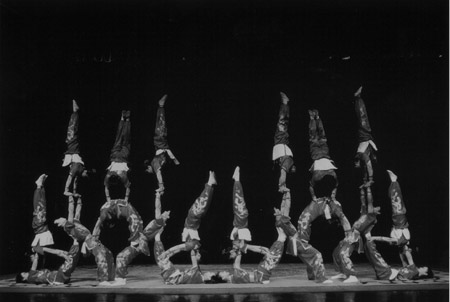Balancing art and culture
Acrobats bring a taste of ancient Chinese custom to Columbia
February 10, 2005
Most people consider standing on their hands a difficult balancing act. But for the National Acrobats of Taiwan, Republic of China, performing handstands on top of a pyramid of eight stacked chairs is not only routine but also a celebration of their heritage. The acrobatic troupe showcases this approximately 2,500-year-old Chinese art in a 12-act variety show designed to bring Chinese culture to Western audiences.
Colorful, sparkling costumes and acts such as tumbling, plate spinning, magic tricks and balancing routines are some of the highlights the program promises to bring to Jesse Auditorium tonight.
The 35-member group is currently on a four-month tour of North America and has performed in Europe and Southeast Asia. The show tonight, which is part of the University of Missouri Concert Series, is the acrobatic troupe’s Columbia debut.
The program was chosen because of the acrobats’ reputation as an outstanding group, says Kimberly Mouser, assistant director for the concert series. “It’s a fun show that appeals to all ages,” she says. “Kids love seeing the acrobats and the different things that they do.”
The acrobats are well-known for their extensive use of everyday items. Some acrobats, for example, attach plates to long, hand-held wires and spin as many as six plates at a time. Others juggle bowls and jars, and acrobats regularly use tables and chairs as props in balancing acts.
In 1980, the group was created to “improve Chinese culture and develop the folk arts,” according to the troupe’s Web site. Stemming from the activities of both daily and military life, acrobatics is a folk-art tradition that has existed since before the Han Dynasty, which began in 206 B.C. Several of the more traditional stunts, such as spinning plates, jumping through hoops and performing handstands on stacked chairs are still commonly practiced by troupes such as the National Acrobats.
Ernest Zhang, an MU doctoral journalism student from Guangzhou, China, remembers watching acrobatic performances as a boy. Today, he says, acrobats are losing some of the interest of Chinese audiences.
“Right now Chinese people have a lot of options for their leisure time,” he says. “When people didn’t have as many ways to spend their leisure time, acrobatics attracted more people.”
Acrobats continue to be popular outside of China, he says. Although troupes still tour the country, Chinese people rarely go to see them more than once or twice in their lives, and the shows are largely tourist attractions, he says. Performance groups have turned
their attention to sharing their acrobatics with the world.
In recent years, Chinese acrobatic troupes have won awards at international competitions, including the Circus of Tomorrow Festival in Paris and the Monte-Carlo International Circus Festival in Monaco.
According to the China National Tourism Administration, there are currently more than 100 troupes throughout China and Taiwan. Many, including the National Acrobats of Taiwan, constantly work to update their performances by incorporating modern enhancements such as lighting techniques and musical accompaniment, at the same time maintaining traditional acrobatic routines.
Becoming a member of the National Acrobats is a prestigious achievement, says Marya Glur, the group’s tour manager for North America. Performers who aspire to join the troupe begin training at the National Taiwan Junior College of Performing Arts when they are 11 years old. Of approximately 300 students who audition each year, the school accepts 50. Those graduates chosen for the troupe are recognized as the best in their field.
Membership in the troupe requires a lot of dedication and time, says Glur. On average, members spend eight years training in acrobatics before joining. The average age of an acrobat is 22, but they range in age from 19 to 52. After joining the National Acrobats, performers spend most of their time rehearsing. To perfect highly dangerous stunts, troupe members practice their individual skills and rehearse as a group for more than six hours a day.
Except for Dante Law, the oldest member of the group, who serves as artistic director, the performers’ roles do not depend on their age, says Glur. Each acrobat perfects a specific ability.
“They each have their specialties, and their specialties are for life,” she says.
The intense training pays off in performances that all audiences enjoy. The acrobatic displays are often greeted by sold-out crowds.
“It’s an opportunity to see the culture of another country,” Glur says. “The show is so entertaining. It has laughs. It has suspense. There are so many amazing feats involved that everybody is entertained.”
— Kate Carpenter

